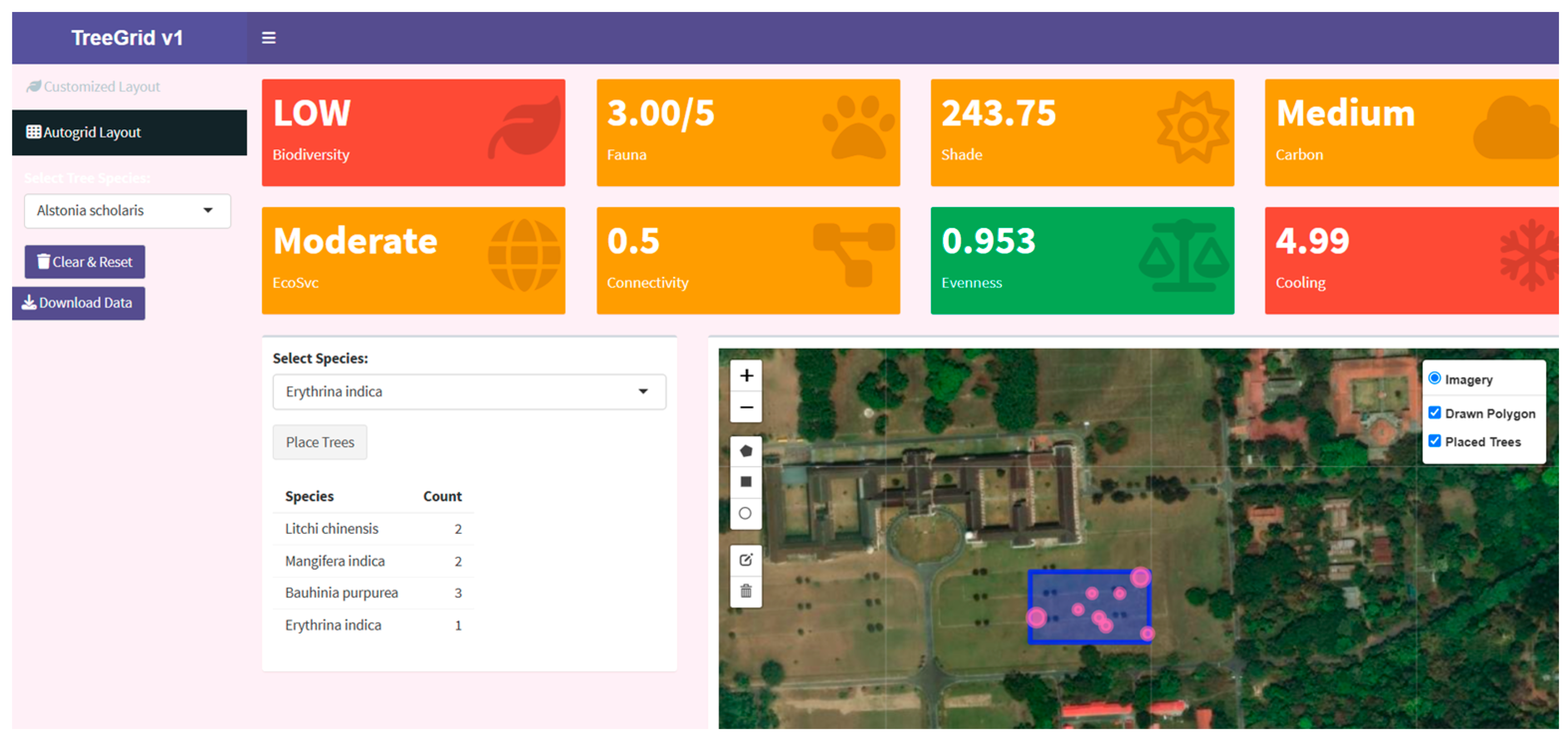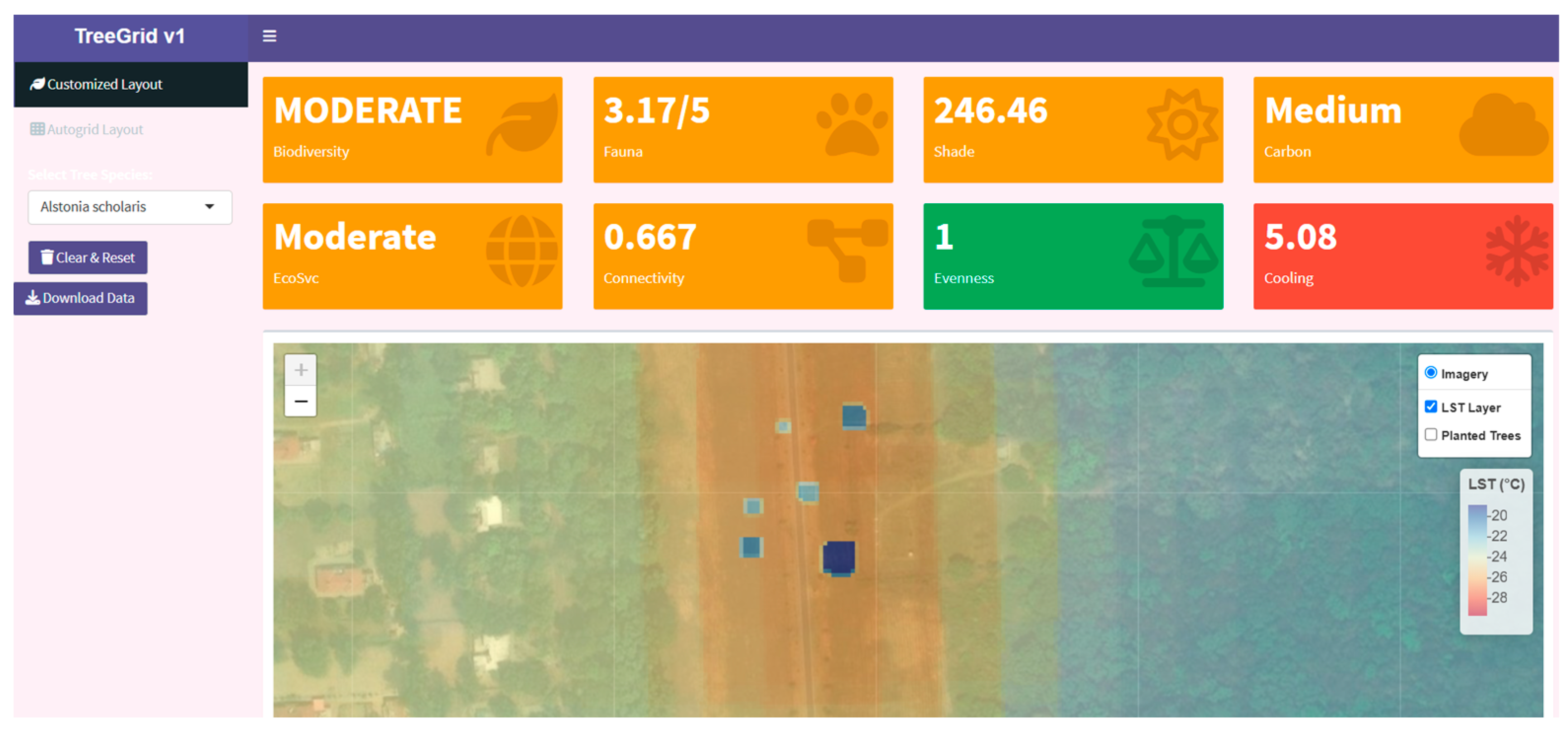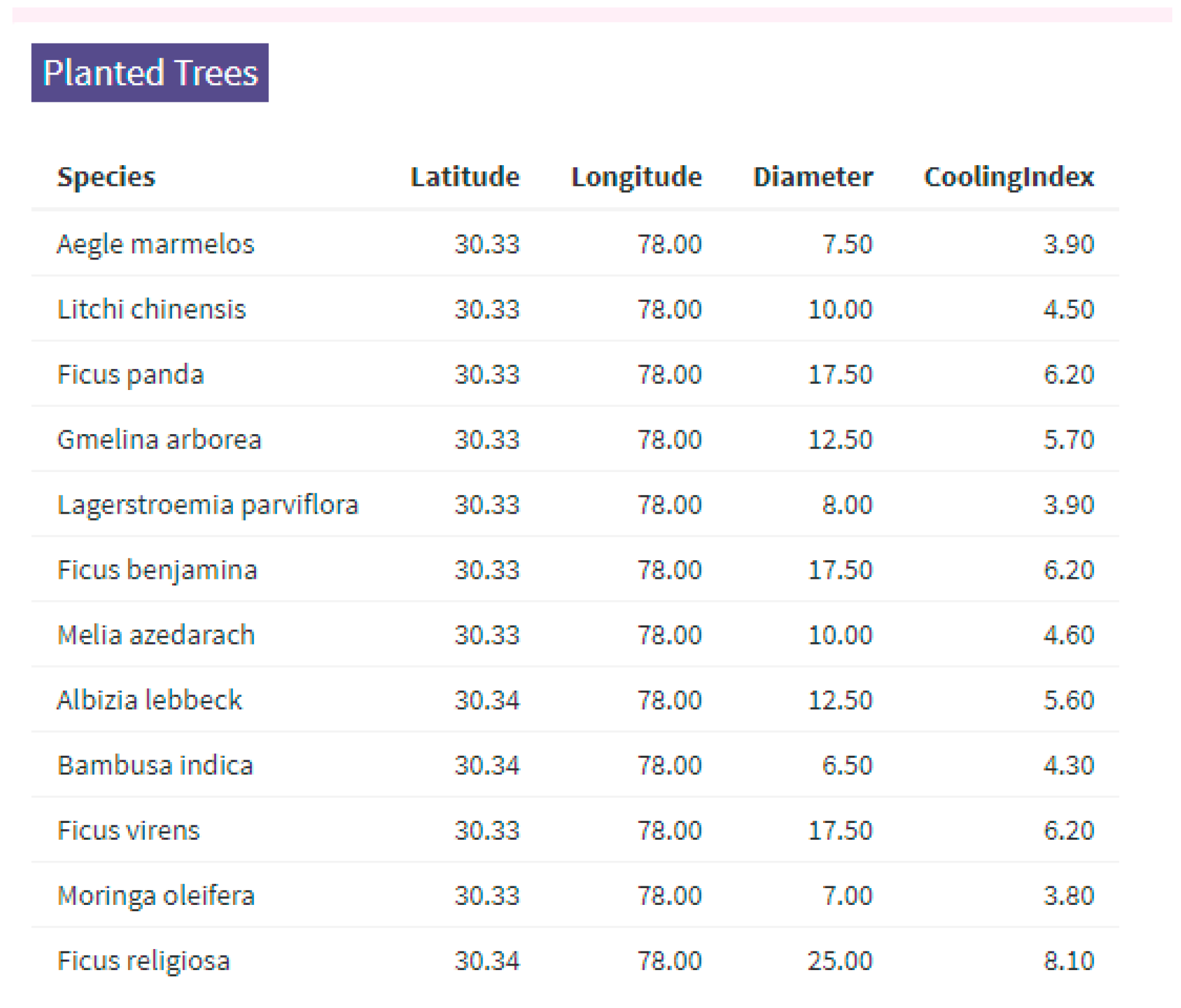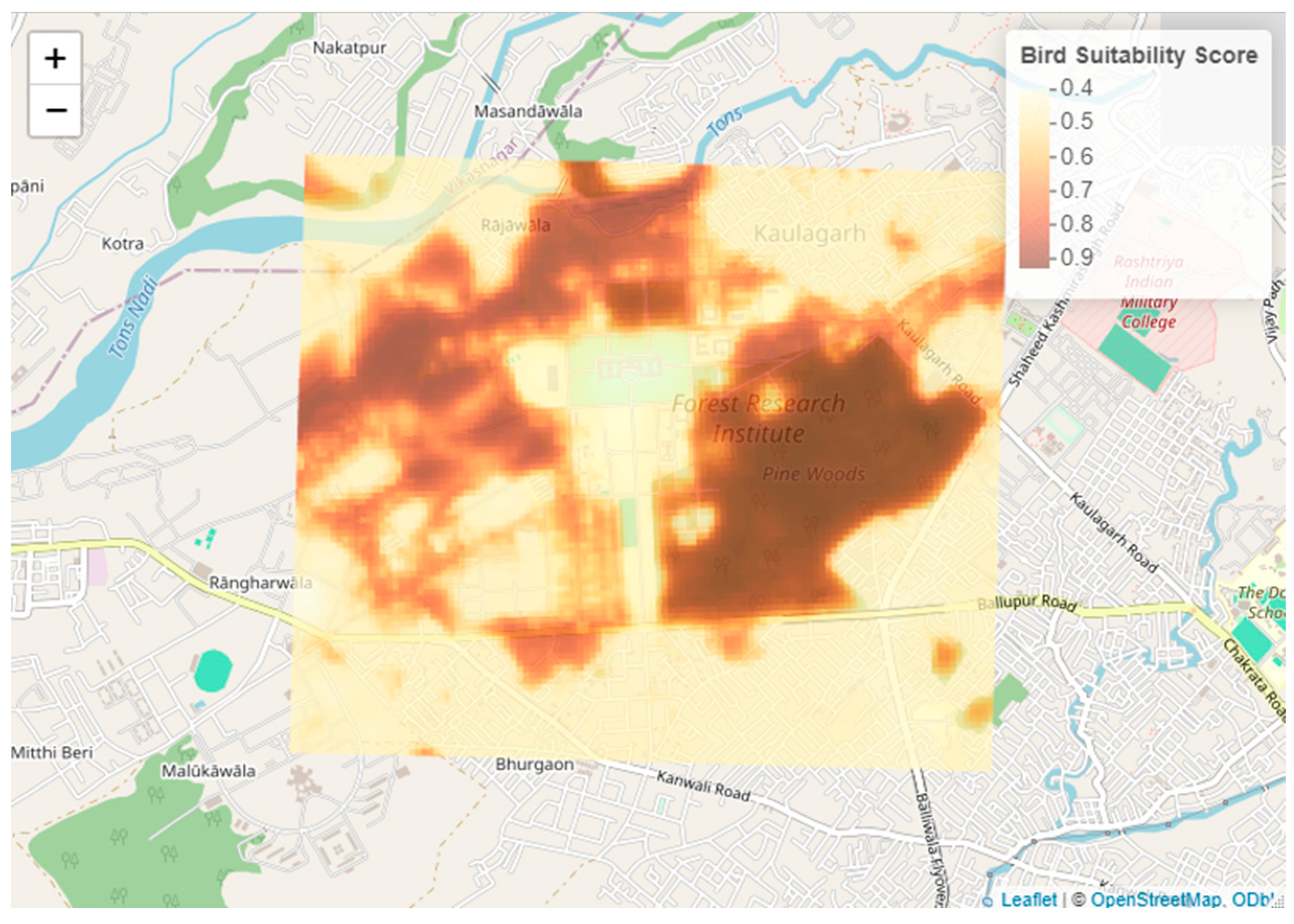TreeGrid: A Spatial Planning Tool Integrating Tree Species Traits for Biodiversity Enhancement in Urban Landscapes
Simple Summary
Abstract
1. Introduction
- Integrating a biodiversity planning module into a spatial tree placement and cooling effect simulation tool will enable dynamic assessments of ecosystem service delivery, habitat suitability, and spatial ecological connectivity within fragmented urban landscapes.
- The tool’s data will be utilized to train deep neural networks (DNNs) to predict habitat connectivity and suitability for urban wildlife species. This will allow high-resolution mapping of biodiversity hotspots, support strategic greening interventions, and strengthen landscape-scale conservation planning efforts.
2. Materials and Methods
2.1. Tool Description
2.2. Ecological Score Computations
2.2.1. Tree Plantings Biodiversity Score
2.2.2. Faunal Biodiversity Score
2.2.3. Shade Index
2.2.4. Carbon Value
2.2.5. Ecosystem Services Score
2.2.6. Connectivity Index
2.2.7. Cooling Index
2.3. Spatial Cooling Effect Simulation
2.4. Predictive Habitat Modelling Based on Deep Neural Network
3. Results
3.1. Tool Interface and Ecological Scores
3.2. Model Performance and Output
4. Discussion
5. Conclusions
Author Contributions
Funding
Institutional Review Board Statement
Informed Consent Statement
Data Availability Statement
Acknowledgments
Conflicts of Interest
Abbreviations
| AUC | Area under curve |
| CBD | Convention for Biodiversity |
| CBI | City Biodiversity Index |
| CI | Cooling index |
| CW | Maximum canopy width |
| DNN | Deep neural network |
| LAI | Leaf area index |
| LST | Land surface temperature |
| PPGIS | Participatory Planning Geographical Information Systems |
| ROC | Receiver operating characteristic (curve) |
| ReLU | Rectified Linear Unit |
| SI | Shade index |
| TH | Maximum tree height |
| UHI | Urban heat island |
| WUI | Wildland–urban interface |
References
- Aronson, M.F.J.; Lepczyk, C.A.; Evans, K.L.; Goddard, M.A.; Lerman, S.B.; MacIvor, J.S. Biodiversity in the city: Key challenges for urban green space management. Front. Ecol. Environ. 2017, 15, 189–196. [Google Scholar] [CrossRef]
- Kowarik, I. Novel urban ecosystems, biodiversity, and conservation. Environ. Poll. 2011, 159, 1974–1983. [Google Scholar] [CrossRef]
- Threlfall, C.G.; Mata, L.; Mackie, J.A.; Hahs, A.K.; Stork, N.E.; Williams, N.S.; Livesley, S.J. Increasing biodiversity in urban green spaces through simple vegetation intAerventions. J. Appl. Ecol. 2017, 54, 1874–1883. [Google Scholar] [CrossRef]
- Ikin, K.; Le Roux, D.S.; Rayner, L.; Villaseñor, N.R.; Eyles, K.; Gibbons, P.; Manning, A.D.; Lindenmayer, D.B. Key lessons for achieving biodiversity-sensitive cities and towns. Ecol. Manag. Restor. 2015, 16, 206–214. [Google Scholar] [CrossRef]
- Apfelbeck, B.; Snep, R.P.; Hauck, T.E.; Ferguson, J.; Holy, M.; Jakoby, C.; MacIvor, J.S.; Schär, L.; Taylor, M.; Weisser, W.W. Designing wildlife-inclusive cities that support human-animal co-existence. Landsc. Urban Plan. 2020, 200, 103817. [Google Scholar] [CrossRef]
- Zhang, J.Y.; Liu, K. Dilemma and Symbiosis: Reviewing the Strate A gies of Wildlife-Inclusive Urban Design and Its Insights for Applications. Landsc. Archit. 2022, 29, 18–25. [Google Scholar]
- Baruch-Mordo, S.; Webb, C.T.; Breck, S.W.; Wilson, K.R. Use of patch selection models as a decision support tool to evaluate mitigation strategies of human–wildlife conflict. Biol. Conserv. 2013, 160, 263–271. [Google Scholar] [CrossRef]
- Rall, E.; Hansen, R.; Pauleit, S. The added value of public participation GIS (PPGIS) for urban green infrastructure planning. Urban For. Urban Green. 2019, 40, 264–274. [Google Scholar] [CrossRef]
- Apfelbeck, B.; Jakoby, C.; Hanusch, M.; Steffani, E.B.; Hauck, T.E.; Weisser, W.W. A conceptual framework for choosing target species for wildlife-inclusive urban design. Sustainability 2019, 11, 6972. [Google Scholar] [CrossRef]
- Cimburova, Z.; Pont, M.B. Location matters. A systematic review of spatial contextual factors mediating ecosystem services of urban trees. Ecosyst. Serv. 2021, 50, 101296. [Google Scholar] [CrossRef]
- Bolund, P.; Hunhammar, S. Ecosystem services in urban areas. Ecol. Econ. 1999, 29, 293–301. [Google Scholar] [CrossRef]
- Yosef, R.; Rakholia, S.; Mehta, A.; Bhatt, A.; Kumbhojkar, S. Land Surface temperature regulation ecosystem service: A case study of Jaipur, India, and the urban island of Jhalana Forest Reserve. Forests 2022, 13, 1821. [Google Scholar] [CrossRef]
- Rötzer, T.; Rahman, M.A.; Moser-Reischl, A.; Pauleit, S.; Pretzsch, H. Process based simulation of tree growth and ecosystem services of urban trees under present and future climate conditions. Sci. Total Environ. 2019, 676, 651–664. [Google Scholar] [CrossRef]
- Elmqvist, T.; Setälä, H.; Handel, S.N.; van der Ploeg, S.; Aronson, J.; Blignaut, J.N.; Gómez-Baggethun, E.; Nowak, D.J.; Kronenberg, J.; de Groot, R. Benefits of restoring ecosystem services in urban areas. Curr. Opin. Environ. Sustain. 2015, 14, 101–108. [Google Scholar] [CrossRef]
- Yadav, N.; Rakholia, S.; Yosef, R. Decision support systems in forestry and tree-planting practices and the prioritization of ecosystem services: A review. Land 2024, 13, 230. [Google Scholar] [CrossRef]
- Werbin, Z.R.; Heidari, L.; Buckley, S.; Brochu, P.; Butler, L.J.; Connolly, C.; Houttuijn Bloemendaal, L.; McCabe, T.D.; Miller, T.K.; Hutyra, L.R. A tree-planting decision support tool for urban heat mitigation. PLoS ONE 2020, 15, e0224959. [Google Scholar] [CrossRef]
- Tabassum, S.; Beaumont, L.J.; Shabani, F.; Staas, L.; Griffiths, G.; Ossola, A.; Leishman, M.R. Which plant where: A plant selection tool for changing urban climates. Arboric. Urban For. 2023, 49, 190–210. [Google Scholar] [CrossRef]
- Deslauriers, M.R.; Asgary, A.; Nazarnia, N.; Jaeger, J.A. Implementing the connectivity of natural areas in cities as an indicator in the City Biodiversity Index (CBI). Ecol. Indic. 2018, 94, 99–113. [Google Scholar] [CrossRef]
- Henry, R.C.; Palmer, S.C.; Watts, K.; Mitchell, R.J.; Atkinson, N.; Travis, J.M. Tree loss impacts on ecological connectivity: Developing models for assessment. Ecol. Inform. 2017, 42, 90–99. [Google Scholar] [CrossRef]
- Caudill, S.A.; DeClerck, F.J.; Husband, T.P. Connecting sustainable agriculture and wildlife conservation: Does shade coffee provide habitat for mammals? Agric. Ecosyst. Environ. 2015, 199, 85–93. [Google Scholar] [CrossRef]
- Hutt-Taylor, K.; Ziter, C.D. Private trees contribute uniquely to urban forest diversity, structure and service-based traits. Urban For. Urban Green. 2022, 78, 127760. [Google Scholar] [CrossRef]
- Wilson, E.O.; Peter, F.M. The Rise of the Global Exchange Economy and the Loss of Biological Diversity. In Biodiversity; National Academies Press: Washington, DC, USA, 1988. [Google Scholar]
- Simkin, R.D.; Seto, K.C.; McDonald, R.I.; Jetz, W. Biodiversity impacts and conservation implications of urban land expansion projected to 2050. Proc. Natl. Acad. Sci. USA 2022, 119, e2117297119. [Google Scholar] [CrossRef]
- Oduro, C.; Lim Kam Sian, K.T.C.; Hagan, D.F.T.; Babaousmail, H.; Ayugi, B.O.; Wu, Y.; Dalu, T.; Wu, N. The influence of land surface temperature on Ghana’s climate variability and implications for sustainable development. Sci. Rep. 2025, 15, 2595. [Google Scholar] [CrossRef]
- Alibakhshi, S.; Cook-Patton, S.C.; Davin, E.; Maeda, E.E.; Araújo, M.B.; Heinlein, D.; Heiskanen, J.; Pellikka, P.; Crowther, T.W. Natural forest regeneration is projected to reduce local temperatures. Commun. Earth Environ. 2024, 5, 577. [Google Scholar] [CrossRef]
- Nitoslawski, S.A.; Galle, N.J.; Van Den Bosch, C.K.; Steenberg, J.W. Smarter ecosystems for smarter cities? A review of trends, technologies, and turning points for smart urban forestry. Sustain. Cities Soc. 2019, 51, 101770. [Google Scholar] [CrossRef]
- Le, Y.; Huang, S.Y. Prediction of Urban Trees Planting Base on Guided Cellular Automata to Enhance the Connection of Green Infrastructure. Land 2023, 12, 1479. [Google Scholar] [CrossRef]
- Chang, G.J. Biodiversity estimation by environment drivers using machine/deep learning for ecological management. Ecol. Inform. 2023, 78, 102319. [Google Scholar] [CrossRef]
- Luna, R.K. Plantation Trees. pp. xiii+–975. Available online: https://www.cabidigitallibrary.org/doi/full/10.5555/20073065038 (accessed on 20 April 2025).
- Troup, R.S. Indian Timbers. J. R. Soc. Arts 1921, 69, 177–188. [Google Scholar]
- Singh, A.; Jerath, N.; Ladhar, S.S.; Singh, G.; Luna, R.K. Tree Directory of Punjab; Designing, Layout & Photo Credits: Mr. Gurharminder Singh Front Cover Photo: Dalbergia sissoo, 094651–82626; Punjab Agricultural University, Ludhiana and Punjab State Council for Science & Technology: Chandigarh, India, 2014; p. 184. [Google Scholar]
- Kendal, D.; Dobbs, C.; Lohr, V.I. Global patterns of diversity in the urban forest: Is there evidence to support the 10/20/30 rule? Urban For. Urban Green. 2014, 13, 411–417. [Google Scholar] [CrossRef]
- Moshood, F.J.; Muhali, M.O.; Ugbong, E.A. Evaluating urban tree diversity and the “10-20-30” rule of urban forestry in Ilorin metropolis, Nigeria. J. Agric. Environ. 2024, 20, 177–187. [Google Scholar]
- Maria, E.; Budiman, E.; Taruk, M. Measure distance locating nearest public facilities using Haversine and Euclidean Methods. J. Phys. Conf. Ser. 2020, 1450, 012080. [Google Scholar] [CrossRef]
- Rahman, M.A.; Stratopoulos, L.M.; Moser-Reischl, A.; Zölch, T.; Häberle, K.H.; Rötzer, T.; Pretzsch, H.; Pauleit, S. Traits of trees for cooling urban heat islands: A meta-analysis. Build. Environ. 2020, 170, 106606. [Google Scholar] [CrossRef]
- Hijmans, R.J.; Bivand, R.; Dyba, K.; Pebesma, E.; Sumner, M.D. Terra [R Package]. November 2023. Available online: https://cran.r-project.org/web/packages/terra/index.html (accessed on 20 April 2025).
- Allaire, J.; Chollet, F. Keras: R Interface to “Keras” [Dataset]. Available online: https://cran.r-project.org/web/packages/keras/index.html (accessed on 20 April 2025).
- Hilty, J.; Worboys, G.L.; Keeley, A.; Woodley, S.; Lausche, B.J.; Locke, H.; Carr, M.; Pulsford, I.; Pittock, J.; White, J.W.; et al. Guidelines for Conserving Connectivity Through Ecological Networks and Corridors; IUCN Best Practice Protected Area Guidelines Series No. 30; IUCN: Gland, Switzerland, 2020. [Google Scholar]
- Tee, S.L.; Samantha, L.D.; Kamarudin, N.; Akbar, Z.; Lechner, A.M.; Ashton-Butt, A.; Azhar, B. Urban forest fragmentation impoverishes native mammalian biodiversity in the tropics. Ecol. Evol. 2018, 8, 12506–12521. [Google Scholar] [CrossRef]
- Calviño-Cancela, M. Effectiveness of eucalypt plantations as a surrogate habitat for birds. For. Ecol. Manag. 2013, 310, 692–699. [Google Scholar] [CrossRef]
- LaPoint, S.; Balkenhol, N.; Hale, J.; Sadler, J.; van der Ree, R. Ecological connectivity research in urban areas. Funct. Ecol. 2015, 29, 868–878. [Google Scholar] [CrossRef]
- Zhu, Y.; Kensek, K.M. Mitigating the urban heat island effect: The Thermal Performance of Shade-Tree Planting in Downtown Los Angeles. Sustainability 2024, 16, 8768. [Google Scholar] [CrossRef]
- Bowler, D.E.; Buyung-Ali, L.; Knight, T.M.; Pullin, A.S. Urban greening to cool towns and cities: A systematic review of the empirical evidence. Landsc. Urban Plan. 2010, 97, 147–155. [Google Scholar] [CrossRef]
- Norton, B.A.; Coutts, A.M.; Livesley, S.J.; Harris, R.J.; Hunter, A.M.; Williams, N.S.G. Planning for cooler cities: A framework to prioritize green infrastructure to mitigate high temperatures in urban landscapes. Landsc. Urban Plan. 2015, 134, 127–138. [Google Scholar] [CrossRef]
- Garcês, A.; Pires, I. The hell of wildfires: The impact on wildlife and its conservation and the role of the veterinarian. Conservation 2023, 3, 96–108. [Google Scholar] [CrossRef]
- Coppoletta, M.; Merriam, K.E.; Collins, B.M. Post-fire vegetation and fuel development influences fire severity patterns in reburns. Ecol. Appl. 2016, 26, 686–699. [Google Scholar] [CrossRef] [PubMed]
- Calviño-Cancela, M.; Chas-Amil, M.L.; García-Martínez, E.D.; Touza, J. Wildfire risk associated with different vegetation types within and outside wildland-urban interfaces. For. Ecol. Manag. 2016, 372, 1–9. [Google Scholar] [CrossRef]
- Davis, C.L.; Bai, Y.; Chen, D.; Robinson, O.; Ruiz-Gutierrez, V.; Gomes, C.P.; Fink, D. Deep learning with citizen science data enables estimation of species diversity and composition at continental extents. Ecology 2023, 104, e4175. [Google Scholar] [CrossRef]
- Wäldchen, J.; Mäder, P. Machine learning for image based species identification. Methods Ecol. Evol. 2018, 9, 2216–2225. [Google Scholar] [CrossRef]
- Bonney, R.; Shirk, J.L.; Phillips, T.B.; Wiggins, A.; Ballard, H.L.; Miller-Rushing, A.J.; Parrish, J.K. Next steps for citizen science. Science 2014, 343, 1436–1437. [Google Scholar] [CrossRef]






| Biodiversity and Ecology Metric | Range | Interpretation and Utility |
|---|---|---|
| Biodiversity Score (Trees) | Low/Moderate/High | Indicates tree species/genus/family diversity; higher score improves ecosystem resilience (species richness and evenness) |
| Faunal Diversity (Faunal Groups) | 0–5 | Reflects potential to support multiple faunal groups; higher values support richer biodiversity |
| Shade Index | 0–875 (species-dependent) | Estimates shading potential based on tree height and canopy width; useful for thermal comfort planning |
| Carbon Value | Low/Medium/High | Indicator for biomass and long-term carbon sequestration potential |
| Ecosystem Services | Low (1–3), Moderate (4–6), High (7+) | Captures multifunctional value of an ecosystem; more services mean more co-benefits |
| Connectivity Index | 0–1 | Evaluates spatial cohesion of planting; helps maintain faunal movement corridors |
| Cooling Index | 2–8 °C | Estimates temperature reduction; useful for UHI mitigation |
| LST Reduction Simulation | Contextual (1–5 °C based on placement and density) | Visualization of spatially simulated LST changes; aids urban microclimate design |
Disclaimer/Publisher’s Note: The statements, opinions and data contained in all publications are solely those of the individual author(s) and contributor(s) and not of MDPI and/or the editor(s). MDPI and/or the editor(s) disclaim responsibility for any injury to people or property resulting from any ideas, methods, instructions or products referred to in the content. |
© 2025 by the authors. Licensee MDPI, Basel, Switzerland. This article is an open access article distributed under the terms and conditions of the Creative Commons Attribution (CC BY) license (https://creativecommons.org/licenses/by/4.0/).
Share and Cite
Rakholia, S.; Yosef, R.; Yadav, N.; Karimloo, L.; Pleitner, M.; Kothari, R. TreeGrid: A Spatial Planning Tool Integrating Tree Species Traits for Biodiversity Enhancement in Urban Landscapes. Animals 2025, 15, 1844. https://doi.org/10.3390/ani15131844
Rakholia S, Yosef R, Yadav N, Karimloo L, Pleitner M, Kothari R. TreeGrid: A Spatial Planning Tool Integrating Tree Species Traits for Biodiversity Enhancement in Urban Landscapes. Animals. 2025; 15(13):1844. https://doi.org/10.3390/ani15131844
Chicago/Turabian StyleRakholia, Shrey, Reuven Yosef, Neelesh Yadav, Laura Karimloo, Michaela Pleitner, and Ritvik Kothari. 2025. "TreeGrid: A Spatial Planning Tool Integrating Tree Species Traits for Biodiversity Enhancement in Urban Landscapes" Animals 15, no. 13: 1844. https://doi.org/10.3390/ani15131844
APA StyleRakholia, S., Yosef, R., Yadav, N., Karimloo, L., Pleitner, M., & Kothari, R. (2025). TreeGrid: A Spatial Planning Tool Integrating Tree Species Traits for Biodiversity Enhancement in Urban Landscapes. Animals, 15(13), 1844. https://doi.org/10.3390/ani15131844








